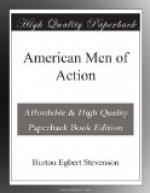Of the youth of Christopher Columbus, as we call him, little is known. No doubt it was much like other boyhoods, and one likes to picture him, in such hours of leisure as he had, strolling about the streets of Genoa, listening to the talk, staring in at the shop-windows, or watching the busy life in the harbor. That the latter had a strong attraction for him there can be no doubt, for though he followed his father’s trade till early manhood, he finally found his real vocation as a seaman. It was on the ocean that true romance dwelt, for it led to strange lands and peoples, and no one knew what wonders and mysteries lay behind each horizon. It was there, too, high courage was developed and endurance, for it was there that men did battle hand to hand with nature’s mightiest forces. It was the one career of the age which called to the bold and adventurous spirit. What training Columbus received or what voyages he made we know not; but when, at about the age of thirty, he steps into the light of history, it is as a man with a wide and thorough knowledge of both the theory and practice of seamanship; a man, too, of keen mind and indomitable will, and with a mighty purpose brooding in his heart.
It was natural enough that his eyes should turn to Portugal, for Portugal was the greatest sea-faring nation of the age. Her sailors had discovered the Madeira Islands, and crept little by little down the coast of Africa, rounding this headland and that, searching always for a passage to India, which they knew lay somewhere to the east, until, at last, they had sailed triumphantly around the Cape of Good Hope. It is worth remarking that Columbus’s brother, Bartholomew, of whom we hear so little, but who did so much for his brother’s fame, was a member of that expedition, and Columbus himself must have gathered no little inspiration from it.
So to Lisbon Columbus went, and his ardent spirit found a great stimulus in the adventurous atmosphere of that bustling city. He went to work as a map-maker, marrying the daughter of one of the captains of Prince Henry the Navigator, from whom he secured a great variety of maps, charts and memoranda. His business kept him in close touch with both mariners and astronomers, so that he was acquainted with every development of both discovery and theory. In more than one mind the conviction was growing up that the eastern shore of Asia could be reached by sailing westward from Europe—a conviction springing naturally enough from the belief that the earth was round, which was steadily gaining wider and wider acceptance. In fact, a Florentine astronomer named Toscanelli furnished Columbus with a map showing how this voyage could be accomplished, and Columbus afterwards used this map in determining his route.




